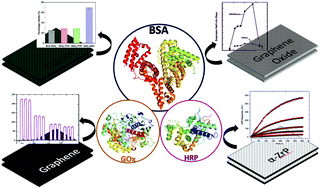Engineering functional inorganic nanobiomaterials: controlling interactions between 2D-nanosheets and enzymes
Abstract
A better understanding of the enzyme-nanosheet interface is imperative for the design of functional, robust inorganic nanobiomaterials and biodevices, now more than ever, for use in a broad spectrum of applications. This feature article discusses recent advances in controlling the enzyme-nanosheet interface with regards to α-zirconium(IV) phosphate (α-ZrP), graphene oxide (GO), graphene, and MoS2 nanosheets. Specific focus will be placed on understanding the mechanisms with which these materials interact with enzymes and elaborate on particular ways to engineer and control these interactions. Our main discoveries include: (1) upon adsorption to the nanosheet surface, a decrease in the entropy of the enzyme's denatured state enhances stability; (2) proteins are used to create biophilic landing pads for increased enzyme stability on many different types of nanosheets; (3) proteins and enzymes are used as exfoliants by shear force to produce biofunctionalized nanosheet suspensions; and (4) bionfunctionalized nanosheets exhibit no acute toxicity. Recognizing proper methods to engineer the interface between enzymes and 2D-nanosheets, therefore, is an important step towards making green, sustainable, and environmentally conscious inorganic bionanomaterials for sensing, catalysis and drug delivery applications, as well as towards the successful manipulation of enzymes for advanced applications.

- This article is part of the themed collections: Inorganic Porous and Layered Material and 2019 Frontier and Perspective articles


 Please wait while we load your content...
Please wait while we load your content...